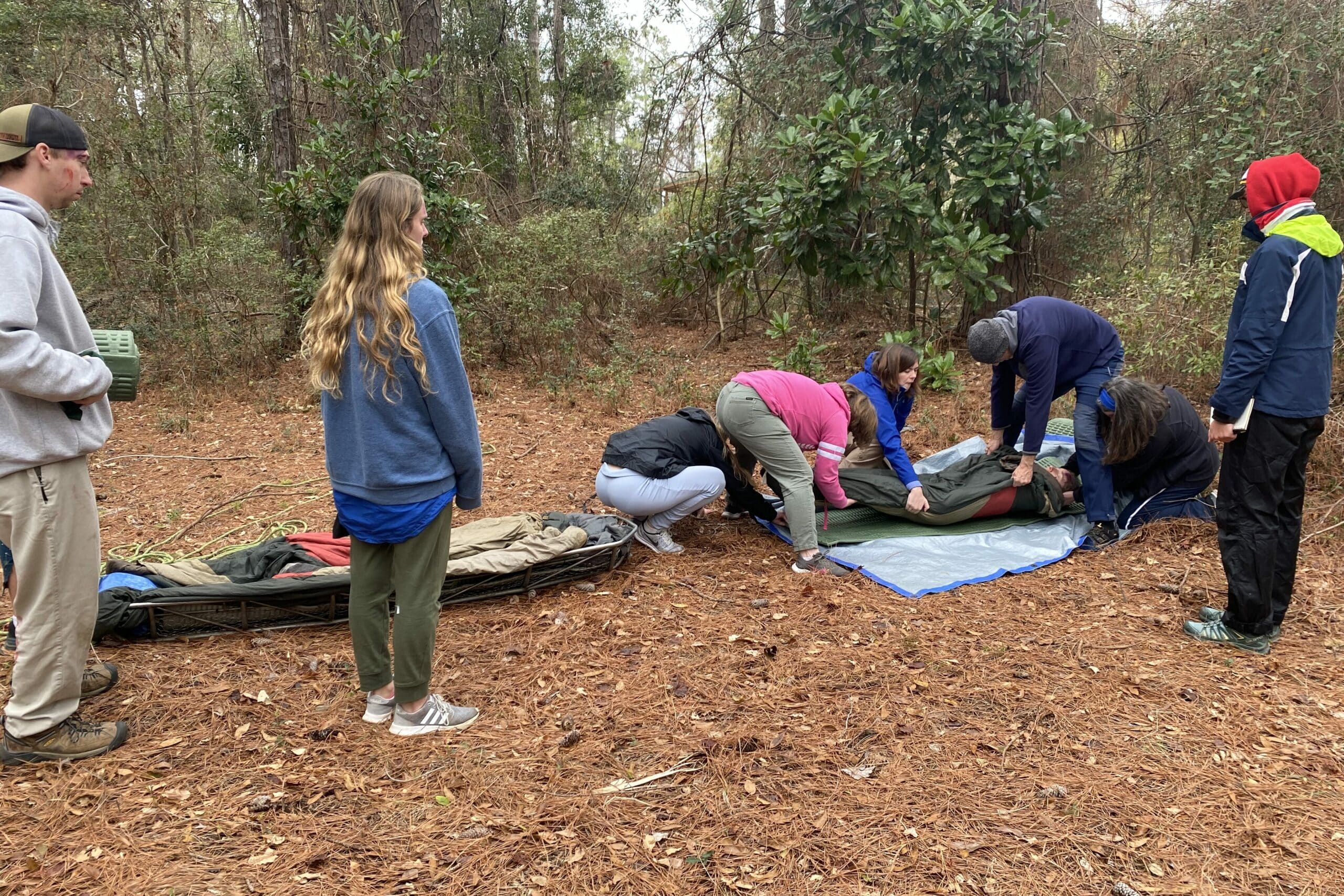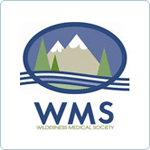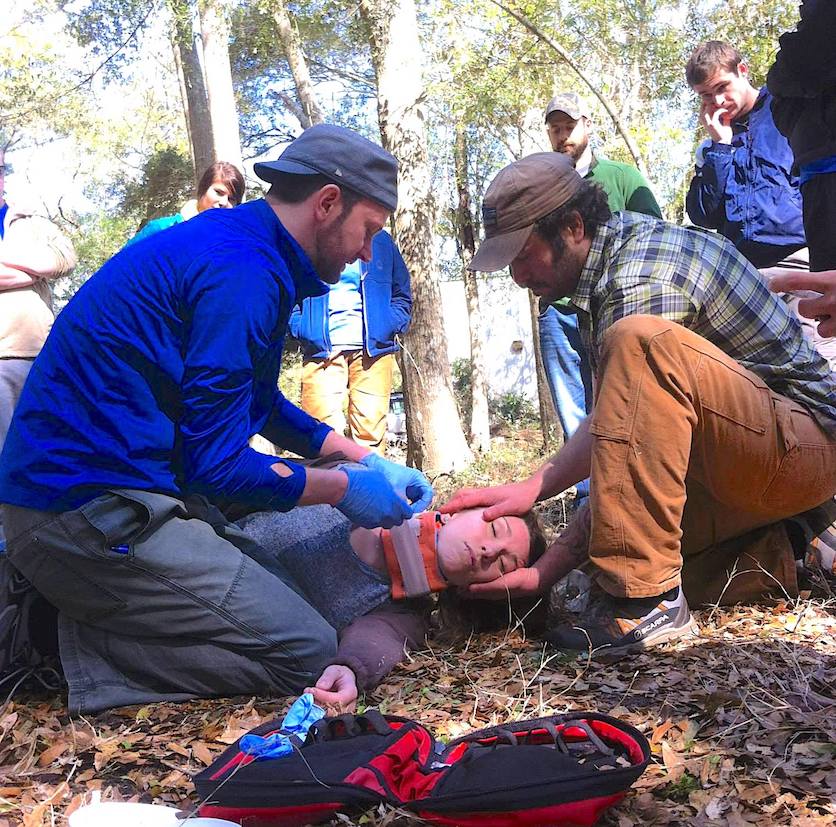New Thinking about How to Handle Spinal Injuries in Remote Wilderness Settings
Wilderness Medicine TrainingBest practices for evaluating and transporting patients with potential spinal fractures or spinal cord injuries is a hot topic in emergency medicine. And it’s no wonder. All of us who work in the adventure programming and emergency medical services field fervently want to avoid causing or worsening a potentially catastrophic injury to someone’s spinal cord.
As such, and for many decades, EMS officials dogmatically insisted that “immobilizing” patients with potential spine injuries was the best protection from further harm. Protocol demanded rigid backboards, cervical collars, head blocks, and yards of tape and straps to prevent someone who is injured from moving. However, new research suggests this is not only ineffective, but quite likely harmful.

Immobilization Dismissed as the Tool of Choice for Patient Transport
Anyone suffering a spinal injury could have a spinal fracture. And that fracture could be unstable. So, if your client (i.e., patient in this case) moved even a little bit (like turning their head), that unstable spinal fracture could slide around and cause spinal cord injury. And that spinal cord injury could cause them to be paralyzed forever.
The Old School solution was to prevent them from moving on their own. Only let trained first responders (including outdoor educators, field instructors, and guides who are certified in wilderness medicine) lift/move the injured patient. Immobilize them to a rigid device — essentially a full-body splint — and get them out of the backcountry and to a hospital.
Upon what was this edict based? Essentially nothing. A few case reports that, on closer scrutiny, don’t indicate any (more…)
Op-Ed: Has the Time Come to Standardize Wilderness Medicine Education and Training?
Wilderness Medicine TrainingThere is no shortage of wilderness medicine education providers in this country. From organizations that offer education and training for Wilderness First Responder (WFR) and Wilderness First Aid (WFA) certifications to those that offer train-the-trainer programs, a simple online search reveals a ton of options — especially when the search is focused on a specific geographical region.
What’s striking about all the wilderness medicine training and certification taking place is that none of it is nationally regulated. None of it adheres to commonly accepted industry standards that govern what’s being taught or how wilderness medicine education and training are being delivered. On the other hand, the training and certification EMTs receive is regulated on a state-by-state level and must meet minimum requirements as set by the National Highway Traffic Safety Administration (NHTSA).
Wilderness medicine training, while loosely adhering to a similar curriculum, is officially overseen by, well, no one. That being said, standardization and oversight aren’t completely absent. Several organizations have attempted to fill the void with a variety of education programs, courses, guidelines, accreditations, and oversight committees.
A Mismash in the Making
Historically speaking, first on the list is the Wilderness Medical Society (WMS) — a nonprofit founded in the early 1980s to encourage, foster, support, and conduct activities that improve the scientific knowledge of human health activities in a wilderness environment. WMS offers three types of advanced wilderness medicine-related certification that have a “continuing education” focus and accreditation connection. The organization’s Fellowship in the Academy of Wilderness Medicine (FAWM), Diploma in Mountain Medicine (DiMM), and Diploma in Diving and Marine Medicine (DiDMM) are all provided in accordance with standards set in part by the Accreditation Council for Continuing Medical Education (ACCME).
There’s also the fledgling Wilderness Medicine Education Collaborative (WMEC) — an ad hoc group of medical educators whose interest in providing guidance on content for wilderness medicine courses has resulted in the creation of minimum guidelines and scope of practice (SOP) documentation for Wilderness First Aid (WFA), Wilderness Advanced First Aid / Advanced Wilderness First Aid(WAFA/AWFA), and Wilderness First Responder (WFR) training. While the work of the collaborative (whose members include leaders from SOLO Wilderness Medicine, Wilderness Medical Associates International, and NOLS Wilderness Medicine, among others) has resulted in a robust set of SOPs, its influence is nonexistent outside those of us who actively choose to look beyond ourselves for best practices. In other words, without accreditation, there’s no real motivation for anyone offering wilderness medicine education to seek out the WMEC. And without a formal structure and an administrative arm, the WMEC has no enforceable authority or meaningful influence.
Speaking of accreditation, closer to home for those us in outdoor and experiential education, following a rapid increase in the number of adventure programs in the late 1980s and early 1990s, it became imperative that outdoor experiential education programs develop standards of program quality, professional behavior, and appropriate risk management. Enter the Association for Experiential Education (AEE), which responded to that need in the early 1990s by developing comprehensive standards for common practices in the adventure education industry, becoming the nation’s first recognized accreditation provider focused on outdoor and adventure-based experiential education programming.
(more…)A Tip of Our Cap to the Wilderness Medical Society
Staff Profiles One thing we don’t do here at The National Center for Outdoor & Adventure Education is work within a vacuum. We depend heavily upon many organizations that went before us or that help us realize our mission and full potential.
One thing we don’t do here at The National Center for Outdoor & Adventure Education is work within a vacuum. We depend heavily upon many organizations that went before us or that help us realize our mission and full potential.
Today, we’d like to shine the light on one of those groups that works behind the scenes to ensure that our efforts in outdoor education, adventure travel and backcountry guiding continue to benefit from standards that keep us and our clients safe and sound in the wilderness.
Specifically, we’d like to tell you briefly about the Wilderness Medical Society (WMS), which was formed in 1983 by three California physicians — Drs. Paul Auerbach, Ed Geehr and Ken Kizer — who integrated the sound principles of medical practice within a wilderness setting.
The specific purpose of the Wilderness Medical Society was to encourage, foster, support, and conduct activities or programs concerned with life sciences, which may improve the scientific knowledge of the membership and the general public in matters related to wilderness environments and human activities in these environments.
As envisioned by these three physicians, WMS evolved into the world’s leading organization devoted to wilderness medical challenges. What challenges? These include wild animal attacks, wilderness trauma, expedition and disaster medicine, dive medicine, search and rescue, altitude illness, and weather-related illnesses.
This society explores health risks and (more…)
TALK TO US
Have any further questions about our courses, what you’ll learn, or what else to expect? Contact us, we’re here to help!
